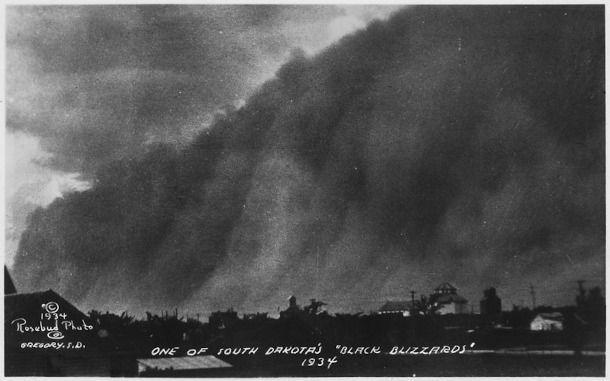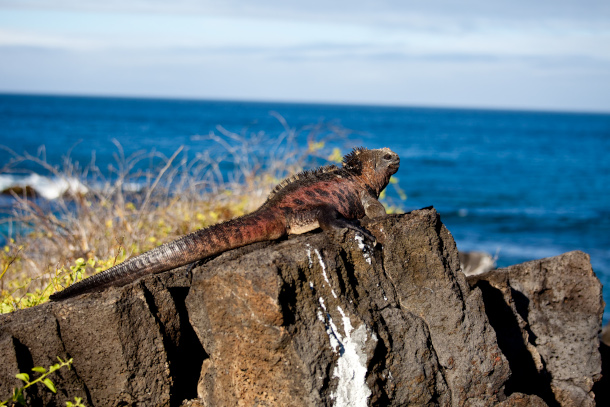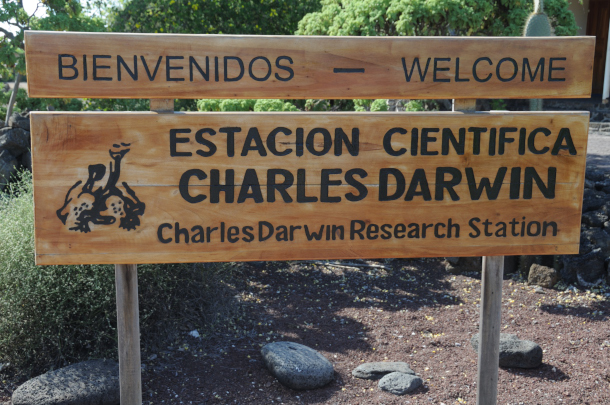From the History Books
Air Date: Week of May 10, 2024

Dust Storms; "One of South Dakota's Black Blizzards, 1934". One of the immense "Black Blizzards" that ravaged the Great Plains region during the Dust Bowl era of the 1930s. Images like this raised awareness of the need for implementing sustainable soil management to prevent such environmental disasters in the future. (Photo: U.S. National Archives and Records Administration, Wikimedia Commons, Public Domain)
Living on Earth contributor Peter Dykstra joins Host Aynsley O’Neill for a trip back in time to a massive dust storm that covered the United States’ eastern seaboard in the 1930s, as well as the start of the Galapagos National Park in Ecuador.
Transcript
BELTRAN: It’s Living on Earth. I’m Paloma Beltran.
O’NEILL: And I’m Aynsley O’Neill.
And joining me now on the line is Peter Dykstra, the Living on Earth contributor who is going to bring us a few stories from the history books. Hey, Peter, what do you have for me?
DYKSTRA: Hi, Aynsley, we're gonna go back 90 years, it's hard to believe it's been 90 years already since the Great American Dustbowl, but on May 12, 1934, what at the time was the worst dust storm in U.S. history, swept off the Great Plains and eventually reached all the way to the East Coast. It was hard to see the Statue of Liberty from Manhattan Island. And in Washington, D.C., there were hearings underway to talk about soil erosion and the dust storm when Congress sees firsthand the damage done by drought and poor land use all the way over 1,000 miles away in the Midwest. The Soil Conservation Service was launched the next year.
O'NEILL: Well, the Soil Conservation Service. What was that? What did that do for us, Peter?
DYKSTRA: It was and is an educational arm that taught farmers how to take that soil and have a permanent positive impact on agriculture, rather than wasting the soil in a few years and having it blow all over the eastern half of North America.
O'NEILL: And 90 years later, still relevant today. Right, Peter?
DYKSTRA: It is. And it's something that farmers have been taught to live by not only in this country, but around the world.
O'NEILL: All right, and Peter, what else do you have for me this week?

A Marine iguana sunbathing on lava rocks in the Galapagos Islands. (Photo: Anthony C, Flickr, CC BY-NC-ND 2.0)
DYKSTRA: Another one that's almost 90 years old. May 14, 1936, the government of Ecuador established the forerunner of what would become the Galapagos National Park. The islands are known for their biodiversity and also their role in Charles Darwin's work, studying evolution. They became a haven for both science and ecotourism, except that the word “ecotourism” wouldn't be around for decades. The park's protected area was expanded in 1959.
O'NEILL: You know, Peter, I actually spent a couple of weeks in the Galapagos in college, and they're pretty serious about protecting their parks, they make sure that you are not bringing in any sort of invasive creatures. It might seem like a bit of overkill, but when you go there, it's really something else. It's like nothing you ever see anywhere else on Earth.
DYKSTRA: Right, and when you back up the value system that so many of us would like to see toward conservation, when you back it up with real money, because the Ecuadorians make money on protecting the environment in Galapagos.

A wooden sign welcoming visitors to the Charles Darwin Research Station in the Galapagos Island, named after the renowned naturalist. Darwin’s study of finches on the island ultimately provided key insights for the theory of evolution (Photo: Scott Ableman, Flickr, CC BY-NC-ND 2.0)
O'NEILL: Alright, Peter. Well, thanks for that trip back in time. Peter Dykstra is a regular contributor to Living on Earth, and we will talk to you again soon.
DYKSTRA: Aynsley, thanks a lot. We'll talk to you soon.
O'NEILL: And there's more on these stories on the Living on Earth website. That's loe.org.
Links
Living on Earth wants to hear from you!
Living on Earth
62 Calef Highway, Suite 212
Lee, NH 03861
Telephone: 617-287-4121
E-mail: comments@loe.org
Newsletter [Click here]
Donate to Living on Earth!
Living on Earth is an independent media program and relies entirely on contributions from listeners and institutions supporting public service. Please donate now to preserve an independent environmental voice.
NewsletterLiving on Earth offers a weekly delivery of the show's rundown to your mailbox. Sign up for our newsletter today!
 Sailors For The Sea: Be the change you want to sea.
Sailors For The Sea: Be the change you want to sea.
 The Grantham Foundation for the Protection of the Environment: Committed to protecting and improving the health of the global environment.
The Grantham Foundation for the Protection of the Environment: Committed to protecting and improving the health of the global environment.
 Contribute to Living on Earth and receive, as our gift to you, an archival print of one of Mark Seth Lender's extraordinary wildlife photographs. Follow the link to see Mark's current collection of photographs.
Contribute to Living on Earth and receive, as our gift to you, an archival print of one of Mark Seth Lender's extraordinary wildlife photographs. Follow the link to see Mark's current collection of photographs.
 Buy a signed copy of Mark Seth Lender's book Smeagull the Seagull & support Living on Earth
Buy a signed copy of Mark Seth Lender's book Smeagull the Seagull & support Living on Earth

